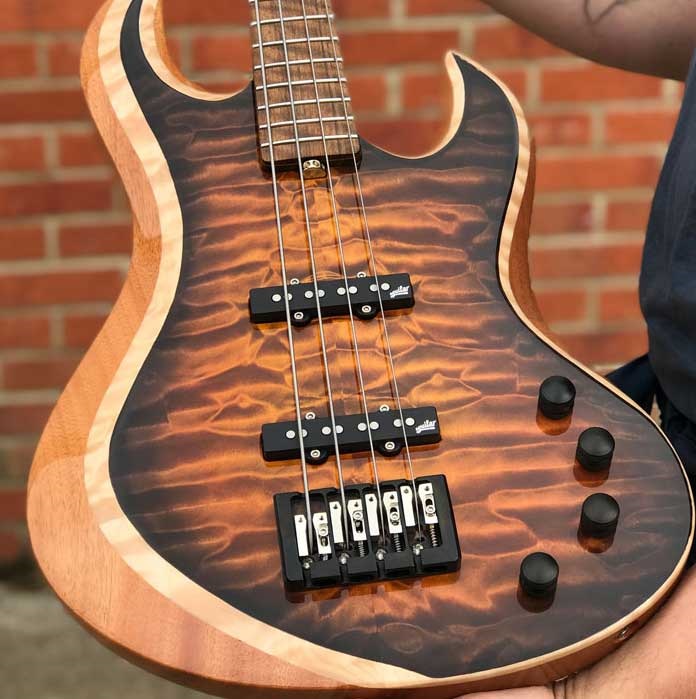The Fender Jazz Bass was originally introduced in 1960 as the “Deluxe” model, and shortly afterward renamed to “Jazz Bass”. From ’60 to ’62, this bass featured stacked knob controls. The chrome upper portion is the volume control and the black lower is the tone control.
What came after the stacked knob controls is what’s still in use today, a three-knob layout of two volume controls and one master tone control, which looks like this:


Are stacked controls “better”?
Stacked controls are not any better nor worse than the three-knob layout, but they are technically more advanced as you’re getting 4 controls instead of 3.
What you get with stacked controls is 2 volume and 2 tone controls instead of 2 volume controls and 1 tone control.
In addition, some bass players do prefer the feel of the metal stacked knobs over the plastic non-stacked.
Is the stacked knob layout easier to use?
This can be clearly answered: No.
The 3-knob is easier for one main reason. Very prominent knob indicator lines.
With the 3-knob layout, a white line shows very clearly where the each knob’s position is. With stacked controls, there are no markers.
Some players don’t care about knob markers, but for others it’s a big deal to see where the position of the knob is at a glance.
What options do we offer if you want the stacked controls?
The easiest solution is to buy it pre-wired. We build these by hand and test every one before shipping it out. This is by far the easiest of the easy as the whole thing gets sent to you ready-to-install.
If you’d rather construct it yourself and just need the parts kit, we have that too. Everything you need is in the kit.
If you don’t need the kit, you can just get the pieces you need, such as the plate, the upper knob, the lower knob, the detent spring plate, and so on. If you need advice on what to get, just contact us.
Is “going 62” worth it?
Stacked controls on a Jazz Bass does give you 4 controls for more tone shaping, and it does make a J-Bass look more upscale by having more shiny stuff in the control area. Fans of vintage J-Basses will also instantly recognize the stacked controls.
It can be safely said that a stacked knob layout will make your Jazz Bass stick out in all the right ways. But whether the layout agrees with you is something you’ll have to find out for yourself.




I’ve heard that the additional tone pot influences the sound of the pickups (I.e. capacitance load from the neck pots can effect the sound of the bridge pickup and visa versa, whether or not they are turned up/down, and that the tone setting on one pickup can bleed over to the other pickup). Any thoughts on this?
I can’t give you any specifics other than to say that I once owned a ’62 stack knob J Bass and an early ’65 J Bass at the same time. I much preferred the tone of the ’65 and I attributed that to the control configuration. The ’62 didn’t have the punch or the great back pickup tone that we all associate with those pre-CBS Jazz Basses. If I had kept the ’62, I would have definitely converted it to the 3 knob configuration.
Interestingly, a good friend of mine had a ’62 Custom Shop Jazz bass that came with the stack knobs. He converted it to the 3 knob configuration and then back to the stack knobs. I played it at during each phase and it reinforced my feelings that the stack knobs somehow rob the bass of a critical component of the tone, or at least a critical component of the tone that I want to hear from a Jazz Bass.
Yes what you have heard is correct. There are really two issues here. One is how independently the 2 tones behave and the other is how a tone control affects the sound even when turned all the way up. One at a time. Independence: on a Best Bass Gear pre-wire the tones will each behave as a master tone when both pickups are on full. Conversely when a pickup is soloed the other pickups tone control goes out of the picture and it is a dedicated tone control. Various mixes of the two pickups result in varying degrees of independence of the tone controls. On the actual Original fender stackpot basses they tried to do something about this. Two small resistors where placed in-between the vol/tone stacks so they behave independently, and it works. The problem with that is in-line resistors are tone-suckers much worse than an extra tone control. I noticed that when Fender did the re-issue 62 bass they omitted the resistors. When I first wired up one of these setups for myself I added a bypass switch for the resistors so I could make an objective decision about them. I rehearsed and gigged with that bass for a few months and decided that Fender had made the right call on leaving out the tone sucking resistors for their reissue. When it came time to wire 62 plates for BBG I left the resistors out. Anyone that wants to hear this for themselves should try it out. These experiments where allot of fun to make for a geek like me. The second issue about what a tone control is what it is doing when it’s turned all the way up? One answer is ‘not very much’, another answer is this. A tone control even turned up all the way has a small amount of treble bleed. It’s a very esoteric detail on bass guitars. On electric guitars we usually have much less or no tolerance for any loss of high end, as high end is primarily what you have on a guitar. On the bass we will usually let it slide as a non issue as bass players are usually all concerned about their low end rather than the highs. If you a bass player looking for a very sparkly tone it might be an issue. This is what ‘no-load’ tone controls are all about. They remove themselves from the signal at the top setting of the tone pot for ‘true bypass’. Usually just for guitars for the aforementioned reasons but no reason they could not go in a bass. I guess if you are really that concerned about treble loss it becomes a question of why even have tone controls at all, or volume controls for that matter, both of which are removing a small amount of treble. If you are hyper-concerned over treble loss try installing a complete circuit bypass switch. That way you still have controls when you want them and a ‘max treble/max output’ setting anytime you need it.
wow Bob wow – that is one in depth summery of the harnesses in question – thanks for that Max!
You can get stack knobs with detent washers so you know where the knob is
I need your help. Myself and a luthier are building a J bass. I want independent tone and volume control for each pickup. I have a 250K push pull tone pot. I need a wiring diagram. Please help! I’m using Seymour Duncan lightning rods
Mi interessa il kit completo senza la piastra se possibile
Grazie
Wish I had seen this previously. I agree, the tones and punch are different? I still have my 1960 Stack Pot and 1964 Jazz Bass, totally different tone and volume. The ‘64 is much louder. With the Stack Pot, I used to inter-change the control sections every now and then with a three knob 1963 version. I recently sold the 1963 control section, with pots and complete with knobs, for £350.00 – to a dealer. This was more than I originally paid for the 1964 Bass. Also, I have a rare Blonde 1958 EB2 – Electric Bass. For volume, this blows away all my Fender Basses.
You might not believe this but I’ve had great results w/Jazz Basses with no tone control at all. There’s more punch, cleaner sound and surprisingly more than enough tones with that set-up. Try it sometime, – I believe some of you will be pleased with the results. Tip: You may have to lower the height of your pickups (especially the neck position) as your sound may be hotter w/less circuitry under the hood. Thank you!
I have a passive bass with j/j pickups, no controls at all (took them out to experiment). Both pickups (single coils) wired in series. Bridge pickup closer to strings to accomplish my tonal taste. GREAT tone, plenty of volume, low punch, mid presence and treble definition. After all, there´s plenty instruments without any control, right? Volume pedal would be a plus, though.